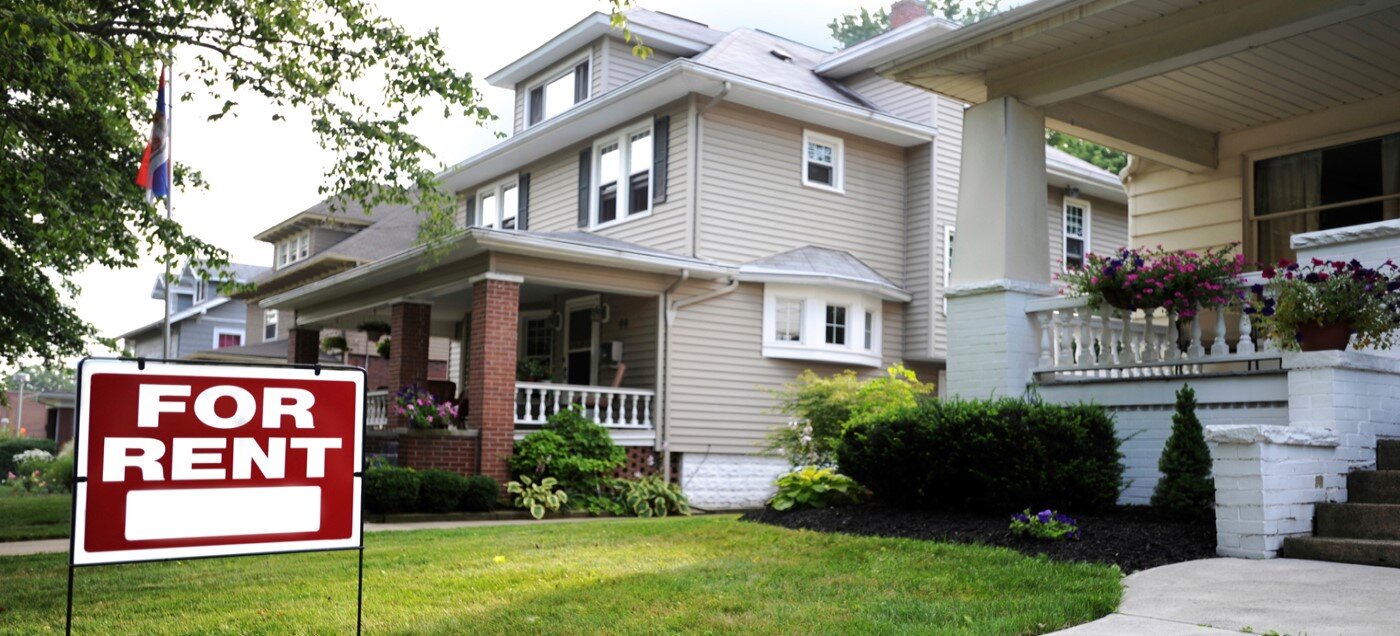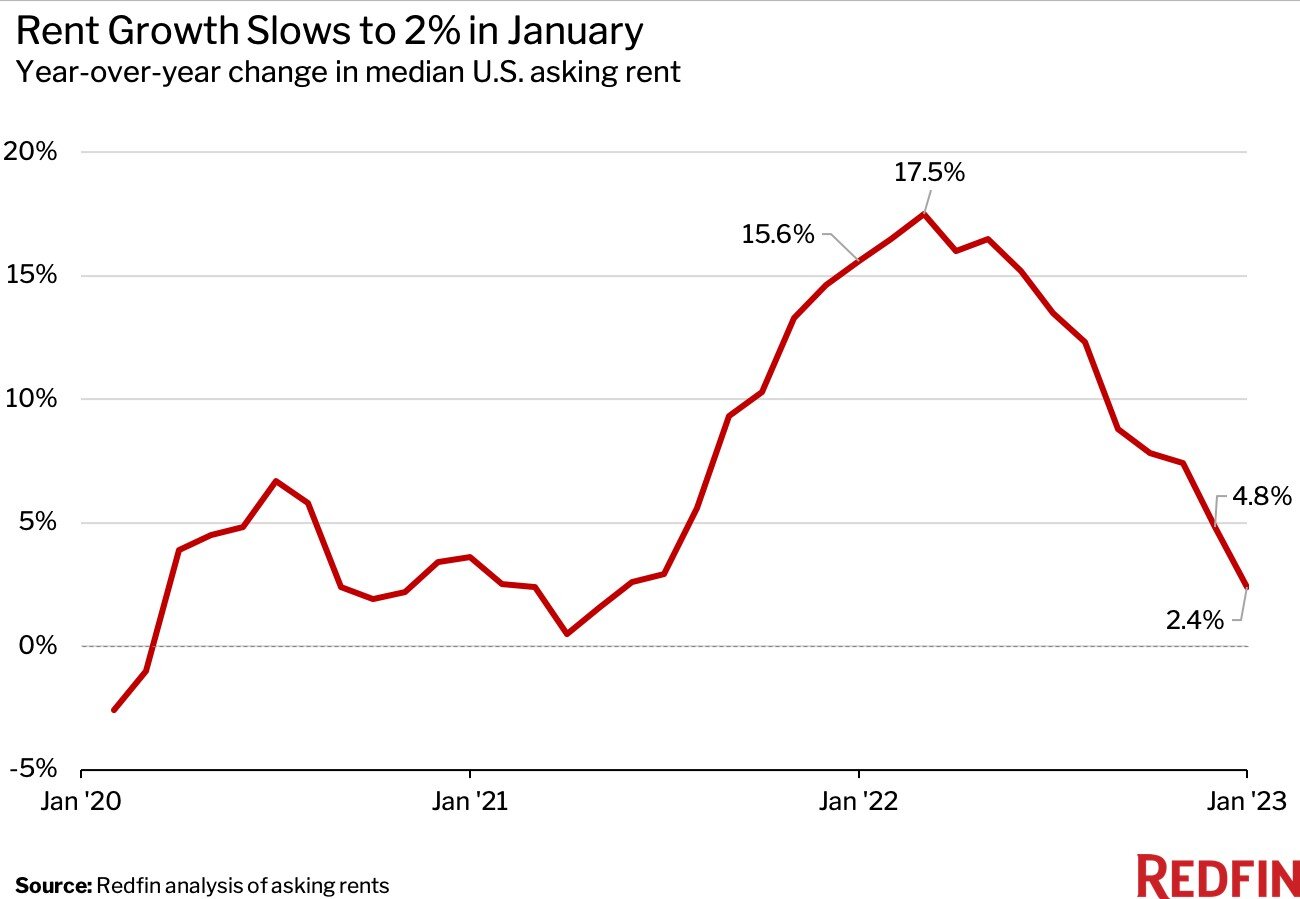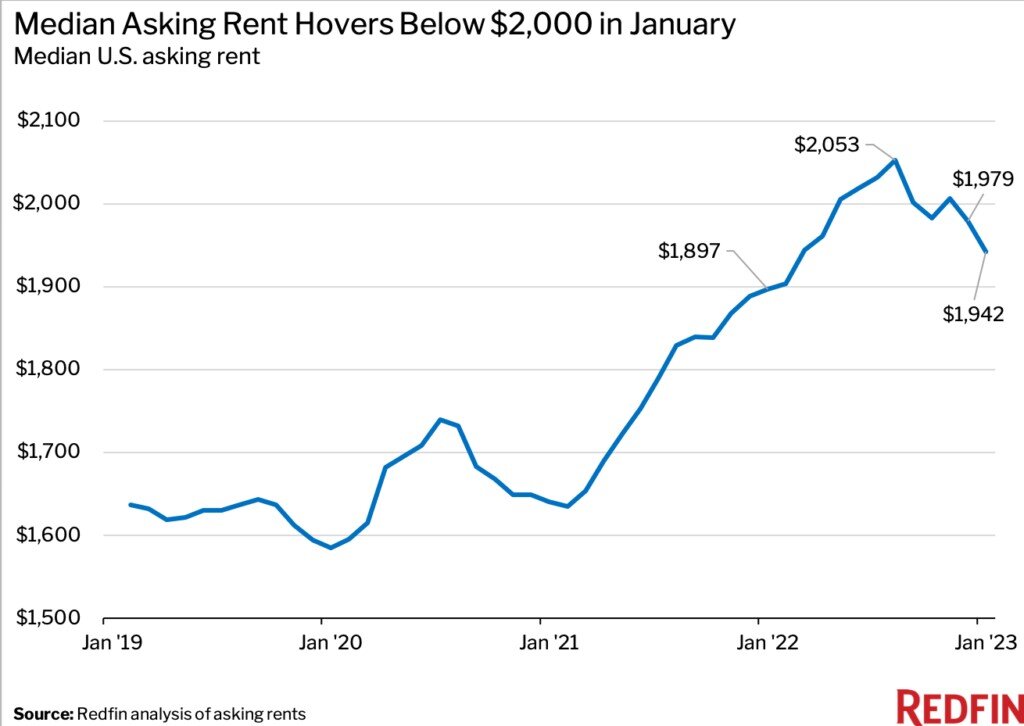Residential Real Estate News

Residential Asking Rents in U.S. Post Smallest Increase in 20 Months in January
Residential News » Seattle Edition | By WPJ Staff | February 15, 2023 9:02 AM ET
According to a new report from Redfin, the median U.S. residential rental asking rent rose 2.4% year over year to $1,942 in January 2023 -- the smallest increase since May 2021 and the lowest level in nearly a year. That's roughly one-sixth the pace of January 2022, when rents were up 15.6% from a year earlier.
January marked the eighth straight month in which annual rent growth slowed. Rents fell 1.9% from a month earlier and were down 5.4% from the August peak of $2,053.
Rent growth is cooling because of slowing demand and growing supply. Demand has slowed due to still-high costs (rents remain 22.5% higher than they were in January 2020), inflation, widespread economic uncertainty and slowing household formation. Rental supply has grown due to an influx of construction in recent years, as well as a recent increase in the number of people opting to rent out their homes instead of sell.

"We're watching closely to see whether rents start falling year over year. That would be a welcome relief for renters because it hasn't happened since the onset of the pandemic," said Redfin Chief Economist Daryl Fairweather. "If rents do start falling on a year-over-year basis, it will mean that renters have more room to negotiate. It may also prompt more landlords to sell their properties because they're no longer getting a good return on their investment."
The nationwide rental vacancy rate stopped falling at the end of 2022 and is expected to grow in the coming months as more rentals hit the market, an indicator that rental prices may continue to slow, Fairweather added.
Rent increases were a significant driver of last year's high inflation, and now, slowing rent growth is expected to help cool inflation in the coming months. In fact, young adults signing new leases now have lower personal inflation rates than the overall U.S. population for the first time in two years, thanks mainly to slowing rent growth.
Rents Declined in 11 Major U.S. Metro Areas
In Phoenix, the median asking rent declined 6.7% year over year in January, the largest drop among the 50 most populous U.S. metropolitan areas. Next came Oklahoma City (-6.3%), New Orleans (-5.2%), Minneapolis (-5.1%) and Houston (-4.9%).
1. Phoenix, AZ (-6.7%)
2. Oklahoma City, OK (-6.3%)
3. New Orleans, LA (-5.2%)
4. Minneapolis, MN (-5.1%)
5. Houston, TX (-4.9%)
6. Baltimore, MD (-4.6%)
7. Birmingham, AL (-3.4%)
8. Chicago, IL (-3.0%)
9. Virginia Beach, VA (-1.8%)
10. Seattle, WA (-1.0%)
11. Austin, TX (-0.4%)
Raleigh Saw the Largest Rent Increase
1. Raleigh, NC (22.5%)
2. Cleveland, OH (17.5%)
3. Indianapolis, IN (14.9%)
4. Charlotte, NC (14.2%)
5. Nashville, TN (9.8%)
6. Kansas City, MO (8.8%)
7. Louisville, KY (8.2%)
8. Milwaukee, WI (7.7%)
9. Jacksonville, FL (7.5%)
10. Providence RI (7.3%)
Sign Up Free | The WPJ Weekly Newsletter
Relevant real estate news.
Actionable market intelligence.
Right to your inbox every week.
Real Estate Listings Showcase
Related News Stories
Residential Real Estate Headlines
- U.S. New-Home Sales Surge in August as Mortgage Rates Ease
- Despite Increased Foreign Buyer Activity, Miami Residential Sales Dip 11 Percent in August
- California Home Sales Enjoy Modest Uptick as Mortgage Rates Ease
- U.S. Home-Flipping Profits Sink to Lowest Level Since 2008 Financial Crisis as Costs Climb
- Why the World's Rich Are Flocking to Europe in 2025
- Federal Reserve Delivers First Rate Cut of 2025 as Mortgage Relief Proves Limited
- Homebuilder Sentiment Holds Steady in U.S. as Rate-Cut Bets Lift Outlook
- U.S. Mortgage Rates Experience Sharpest Weekly Drop in Over a Year
- U.S. Foreclosures Rise for Sixth Straight Month as Affordability Pressures Mount
- Black U.S. Homeownership Rate Falls to Two-Year Low as Job Losses Mount
- Las Vegas Home Prices Flatten as Listings Surge, Sales Slow
- Cooling Miami Housing Market Sees 16 Percent Annual Sales Drop in July
- U.S. Mortgage Delinquencies Uptick in June Amid Regional Pressures
- California, Florida Top U.S. Housing Markets Most at Risk of Downturn
- 30-Year Mortgage Drops to 6.56 Percent in Late August, Lowest Since October 2024
- Investors Maintain Elevated Role in U.S. Housing Market Despite Slight Pullback
- Pending Home Sales Show Mixed Signals as U.S. Buyers Remain Cautious
- Canadian Home Sales Extend Recovery in July
- U.S. Home Sales Rise in July as Buyers Gain More Bargaining Power
- Zombie Foreclosures Edge Up Across U.S.
- 2.6 Million Homes at Wildfire Risk Across 14 Western States in 2025
- One in Five Americans Willing to Trade Personal Safety for Home Affordability
- U.S. Home Price Growth Slows as Affordability Pressures Mount in 2025
- U.S. Mortgage Rates Dip to Four Month Low in Early August
- U.S. Mortgage Applications Rise in Late July, Breaking Four-Week Slump
- Hong Kong's Housing Market Stuck in Stalemate as Bulls and Bears Face Off
- U.S. Condo Market Struggles in 2025
- U.S. Pending Home Sales Remain Sluggish in June
- Los Angeles Area Wildfires Destroyed Nearly $52 Billion in Homes Last January
- Greater Palm Beach Area Residential Sales Slip in June Amid Growing Inventory
- Economic Resilience Lifts U.S. Housing Outlook Going Forward
- New Home Sales Stagnate as Affordability Struggles Continue in America
- U.S. Housing Market Slips in June as Prices Hit New Highs
- Florida, California Continue to Reign Supreme as America's Ultraluxury Housing Markets
- Caribbean Housing Market Evolves into Global Second-Home Hotspot
- U.S. Home Sales See Highest June Cancellation Rate on Record
- Orlando Housing Market Cools in June as Listings Slide, Sales Slow
- Private Credit Surges in 2025 as Real Estate Developers Bypass Banks
- U.S. Condo Market Suffers Sharpest Price Drops in Over a Decade as Buyers Retreat
- Rising Taxes, Insurance Costs Undermine the Stability of U.S. Homeownership









